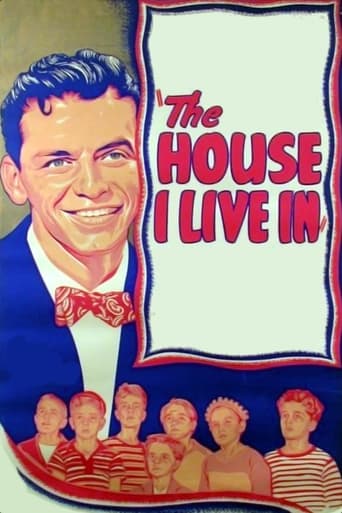NekoHomey
Purely Joyful Movie!
Protraph
Lack of good storyline.
Sabah Hensley
This is a dark and sometimes deeply uncomfortable drama
Allissa
.Like the great film, it's made with a great deal of visible affection both in front of and behind the camera.
bkoganbing
This short subject gathered kudos from all kinds of places for its plea for religious toleration. After a session at a recording studio Frank Sinatra leaves and comes upon a group of kids beating up on another because he was Jewish. He lectured them as only an American icon could about the meaning of prejudice and what we had just fought for against the Nazis. The meaning could not be clearer.Both songs from this short subject were recorded and sold big for Columbia records. If You Are But A Dream and the song written for the film, The House I Live In. The latter is one of the best songs about an idealized version of America, we'd all like to strive for.Sinatra in fact recorded The House I Live In again during the Sixties for a joint album he did for his Reprise record label. The album is now a rarity and it shouldn't be. His collaborators were Bing Crosby and Fred Waring and his Pennsylvanians with the orchestra conducted by Nelson Riddle.Axel Stordahl was Sinatra's primary music conductor and arranger during the forties. When he died that position eventually fell to Nelson Riddle. Stordahl does the orchestration for the short and the Columbia record, Riddle for the Reprise record. Sinatra aficionados and others should listen to both back to back and compare. And catch this worthwhile film whenever it is shown.
harry-76
This eleven minute film that came out toward the end of WW2 conveyed a message of religious tolerance and acceptance of people's differences.It's notable in that it featured a young Frank Sinatra, singing two very beautiful songs, "If You Are But a Dream" and the title song. Both have rich orchestral arrangements by Alex Stordahl, one of Sinatra's favorite music directors at the time.Earl Robinson, composer of the title song, was also noted for his "Ballad for Americans," which Paul Robeson made famous. In spite of these two nobly patriotic compositions, Robinson was one of the "blacklisted" artists (along with Robeson) by the House of Un-American Activities, which today seems ironic.Not available on DVD or VHS at this writing, "The House I Live In" was seen on tv following a showing of Sinatra's debut film, "Higher and Higher." Although Frank's voice is lighter here than generally remembered, it still exhibits his trademark smooth lines, firm breath control and clear diction. His acting forecasts his later work, and the film makes its admirable points within a short time frame.
cjgruner
This is a very excellent movie. Although it is very short (10 minutes or so) it shows an ideal of America. Frank Sinatra used this vehicle to show his attitude toward this ideal of tolerance and understanding. It is worth seeing by just about anyone but I would especially like to see it shown to young people. It is probably too short to ever be a commercial success and I have not been able to find a VHS or DVD copy of it anywhere. I have only seen it twice and heard the complete sound track (not just the music, but the entire dialog as well) twice. I would certainly like to have it in my personal collection.
Ron Oliver
An RKO Short Subject.A group of rowdy little bullies are given a lesson in tolerance by crooner Frank Sinatra, who compares America to THE HOUSE I LIVE IN.This little film delivers a pertinent message about the evils of prejudice & bias. Sinatra is an absolute natural in front of the camera; intense & sincere, he is the perfect spokesperson for the values espoused here.Sinatra sings ‘The House I Live In,' by Lewis Allan & Earl Robinson. This fine tune, with a solid, pro-American message, is being given something of a comeback since the horrendous events of September 11, 2001.After Pearl Harbor, Hollywood went to war totally against the Axis. Not only did many of the stars join up or do home front service, but the output of the Studios was largely turned to the war effort. The newsreels, of course, brought the latest war news into the neighborhood theater every week. The features showcased battle stories or war related themes. Even the short subjects & cartoons were used as a quick means of spreading Allied propaganda, the boosting of morale or information dissemination. Together, Uncle Sam, the American People & Hollywood proved to be an unbeatable combination.

